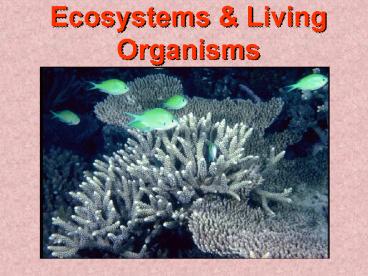Ecosystems - PowerPoint PPT Presentation
1 / 51
Title: Ecosystems
1
Ecosystems Living Organisms
2
How Did Life Evolve?
- Best hypothesis
- Chemical Evolution
- 1 billion years
- Biological Evolution
- 3.7 billion years
- Prokaryotes--gt Eukaryotes--gt Diversification
3
(No Transcript)
4
Characteristics of Kingdoms
- Archaebacteria
- Eubacteria
- Prokaryotes
- Single-celled
- Decomposers
- Help in digestion
- Can cause diseases
5
Protista
- Eukaryotic
- One-celled
- Some algae
- Ponds and sea
- Some cause disease
6
Fungi
- Eukaryotic
- Mostly multicellular
- Chitin cell wall
- Decomposers
- Mutualistic
7
Plants
- Eukaryotic
- Multicellular
- Photosynthetic
- Cellulose cell wall
- Annuals and perennials
8
Animals
- Eukaryotic
- Multicellular
- Heterotrophic
- No cell wall
- Invertebrates Vertebrates
9
Biological Communities
- Producers Consumers
- Decomposers
10
(No Transcript)
11
Biological Communities
- General characteristics
- Lack defined boundaries
- Organisms and interactions are never isolated
12
Keystone Species
- Key members of community
- Need certain limited resources.
- Critical element when describing an ecosystem
13
Keystone Species
- NOT always most abundant
- ALWAYS most important
14
Keystone Species
- One of the keys to conservationist efforts
- Grey wolf of Yellowstone Park
15
Why is the gray wolf a keystone species?
- Gray wolves eat elk. Leftovers provide food for
ravens, eagles, and bears. - Too many elk overrun important vegetation that
provide habitat for birds and food for beavers.
16
Interactions Among Organisms
- Predation
- Pursuit and ambush
- Plant defenses against herbivores
- Defensive adaptations
17
What is Predation?
- Predation members of a predator species prey on
members of a prey species, but do not live in or
on the prey.
18
Predator Strategies
- Structural advantages
- Natural Weapons - Fangs, claws
- Flexible bodies
- Larger Size
19
Predator Strategies
- Ambush-
- Stalk a victim
- Gape Suck (fish)
- Keen eyesight
- Venom
20
Predator Strategies
- SPEED CUNNING
- More intelligent than prey
- Run faster than prey
- Hunt in packs
21
Prey Strategies
- Defense Techniques
- Inflate
- Flee
- Fight Back
- Stab
- Poison
22
Prey Strategies
- Structural advantages
- Hard Body Coverings
- Thorns or Spines
- Break away body parts
- Natural Weapons
23
Prey Strategies
- Chemical Warfare
- Blinding ink
- Poison
- Offensive Smells and Tastes
24
Prey Strategies
- Camouflage
- Color Change
- Counter-shading
- Disruptive Patterns
- Mimicry
25
Mimicry
- Mostly a prey technique
- Optical and sonic illusions
- LOOKS like a predator
- School of fish, false eyes, frilled neck, and
inflation
26
Predation Feedback Systems
- Positive feedback for predator
- gets to eat prey
- Negative feedback
- prey population falls, no food, decrease in
predator population
27
Interactions Among Organisms
- Symbiosis
- Mutualism
- Commensalism
- Parasitism
28
Mutualism
- Both Species Benefit
- Rhinos and oxpeckers
- Trees and fungi
- Ants Acacia (ants keep other predators away
from acacias) - Pollination
29
The Evolution of Mutualism
- Evolved from more negative associations
- Organism impacted had two options
- Escape relationship
- Or adapt to it make it self-advantageous
30
An Example of Mutualism
- Ant and Aphid
- Ant protects aphids eggs, feeds larva, tends
them, keeps them safe - Aphid supplies the ant with food
- Honeydew it secretes from its body
31
Mycorrhizae
- Symbiotic fungus
found on plant roots - Aids in water
retention, mineral
uptake
32
Truffles
- Most expensive food in the world, by mass
- Only found on deciduous tree roots
- Cannot be
cultivated - Unique,
delicious taste
33
Rhizobia
- Symbiotic bacteria found in nodules on legume
roots (soybeans, peas) - Fix nitrogen
- Natural
fertilizers
34
Pollination
- Need insects, bats, birds, and some mice to
assist them - Animals eat nectar and pollen
35
Obligate Mutualism
- Required for the survival of both species
- ex. Yucca and yucca moth, lichens
36
Co-Evolution
- The Yucca Moth and the Yucca flower are
mutualistic
37
The Yucca Relationship
- Yucca gets pollinated
- Moth gets place to lay eggs and obtain food
- Pollination fluctuates non-randomly
38
Commensalism
- One member is helped, the other neither benefits
or is harmed - Epiphytes and forest trees
- Pearl fish Sea Cucumber
39
Parasitism
- and - relationship
- Parasite benefits, host loses
- Parasite usually smaller than host
- Parasites ARE NOT predators. They usually do not
kill their hosts
40
Nematodes
41
The Ecological Niche
- Each organism has a role in an ecosystem (fills a
niche). Think of a niche like a job. - Fundamental niche the entire range of suitable
conditions for a species, without taking into
account predators or interspecific competition - Realized niche the actual occupied niche
42
Competitive Exclusion
- Two species with similar requirements cannot
occupy the same niche. (Gauses Law) - One will either die out, or one will have to find
a new niche.
43
(No Transcript)
44
(No Transcript)
45
(No Transcript)
46
Intraspecific Competition
- Between SAME species intense why?
47
Interspecific Competition
- DIFFERENT species less intense, Why?
- Slightly different requirements
48
Solving the Problem
- Leave
- Emmigrate
- Die
- Extinction
- Adapt
- Resource Partitioning
49
Solving the Problem
50
Limiting Factors
- Major factor in defining an organisms niche
- Tall trees cannot grow in desert
- Water is limiting
51
Other Limiting Factors?
????

